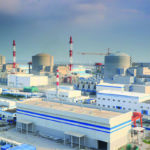A government-run development bank is expected to end its ban on investment in nuclear energy, a move that could allow U.S. companies to take a greater role in foreign nuclear power projects.
The U.S. International Development Finance Corporation (DFC) as early as this week could lift its prohibition on supporting nuclear power. The DFC on June 10 began a 30-day public comment period on a proposed change to the agency’s Environmental and Social Policy and Procedures. The change would enable the group to consider supporting nuclear power projects, aligning the DFC’s definition of renewable energy with that of the U.S. Energy Information Administration (EIA).
Some companies have been exporting their advanced nuclear technology to foreign countries, but without U.S. government support. This move by the DFC could help the U.S. better compete with Russia and China, which have taken the global lead in exporting nuclear technology.
Maria Korsnick, president and CEO of the Nuclear Energy Institute, in a recent webcast about the state of the U.S. nuclear industry, said of the move: “I think it’s a huge step forward … it’s very, very significant.”
Renewable, Zero-Emission Resource
Korsnick and others involved in the U.S. and global nuclear power industry have said nuclear is important to help mitigate climate change, and as a zero-emission source of power should be considered alongside renewable resources such as solar and wind when it comes to government backing. Korsnick on the webcast, attended by POWER, said, “I’ve never been more confident in the future of nuclear energy. Nuclear power isn’t only about generating electricity. When it comes to technology, we’ve often seen how the right technology at the right time can improve our lives in ways we didn’t think were possible.”
The DFC in posting the notice of public comment on the proposed change said, “Modernizing DFC’s policy to offer financing for nuclear projects supports the agency’s development mandate, bolsters U.S. foreign policy, and recognizes advances in technology which could make nuclear energy particularly impactful in emerging markets.” The development bank, and its predecessor Overseas Private Investment Corporation, had been prohibited from investing in nuclear power. The group said the change in part is due to Trump administration support of the U.S. nuclear industry.

The DFC has a total investment limit of $60 billion. It supports projects in emerging markets through equity financing, debt financing, political risk insurance, and technical development. U.S. companies in particular have been working on advanced nuclear technologies including small modular reactors (SMRs) and microreactors, which have lower costs than nuclear power plants such as the Vogtle expansion currently underway in Georgia.
Tough for U.S. to Compete
U.S. companies also have lamented the difficulties of competing globally on nuclear technology with countries such as China and Russia, which have government-supported nuclear programs. Rosatom, Russia’s state-owned nuclear arm, last month signed a memoranda of understanding with France’s Framatome SAS and General Electric (GE) Steam Power as part of the strategic investor selection procedure for the Belene Nuclear Power Plant (NPP) in Bulgaria. Rosatom already has successfully collaborated with Framatome SAS and GE on other international projects, including the Paks-2 NPP in Hungary, and the Hanhikivi-1 NPP in Finland.
Other Rosatom and GE collaborations include the Akkuyu NPP project in Turkey, and the El-Dabaa NPP project in Egypt, where a joint venture between GE and Rosatom is a supplier of equipment for the turbine island.
“Over the last 14 years, we’ve connected 15 power units , as well as a floating NPP, to the grid and were the first to have the latest generation [called “generation 3+”] reactors up and running,” Ryan Collyer, acting CEO of Rosatom Central and Southern Africa, recently told POWER. “We have projects of 36 power units at various stages of implementation in 12 countries, more export new build projects than all our competitors combined.”
Rosatom’s technology includes the latest versions of its VVER-1200 and VVER-TOI reactors. The VVER is a water-water energetic reactor. Rosatom recently said the reactors will be utilized at new sites in the Leningrad and Smolensk regions of Russia. They already are in use in several countries, including China, Finland, Germany, Hungary, Slovakia, Bulgaria, India, and Iran, according to Rosatom. The group recently told POWER it has secured more than 30 reactor supply deals in recent years, and in 2019 the company said it had international projects worth $202.4 billion in its portfolio. The company also said it has 36 reactor construction projects outside of Russia at various implementation stages.
Rosatom also told POWER that the OKB Gidropress research and experiment facility, part of the Rosatom machinery division Atomenergomash, has started life tests of a mock-up of the third-generation nuclear fuel RK3+ for VVER-440 reactors. The tests are being conducted as part of a contract between Rosatom’s TVEL Fuel Company, and Czech power company ČEZ a.s. The tests include design and introduction of the modified fuel at the Dukovany NPP in the Czech Republic.
China, meanwhile, is expected in 2022 to pass France as the world’s No. 2 generator of nuclear power, according to GlobalData PLC. The group predicts China will take over the top spot from the U.S. by 2026, with a goal of generating 130 GW of nuclear power by 2030.
Delegates to an annual parliamentary meeting in Beijing that ended last week suggested that China should start construction on six to eight reactors a year.
Banks Could Change Strategies
Korsnick last month said other large financial institutions, such as the World Bank, might also reconsider their investment strategies and move to support SMRs and microreactors. Small nuclear deployments are among the areas POWER is focused on for its upcoming Distributed Energy Conference, with those technologies designed to provide power and promote economic growth in areas without access to reliable electricity.
Nuclear power also was the subject of a recent POWER webcast, which is available for on-demand viewing.
The DFC’s proposed change would implement a recommendation made in an April 2020 report issued by the U.S. Nuclear Fuel Working Group, an interagency initiative to review and modernize U.S. nuclear energy policy.
—Darrell Proctor is associate editor for POWER (@DarrellProctor1, @POWERmagazine).










